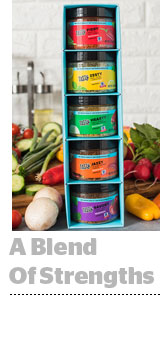
McCormick, the 130-year-old seasoning manufacturer, worked together with BuzzFeed’s food publication Tasty to co-develop Tasty-branded seasonings.
For BuzzFeed, selling co-branded products is a revenue opportunity that supplements its ad business. For McCormick, which usually sells in supermarkets, it’s an opportunity to reach millennial chefs and to directly get both customer data and distribution – usually the privilege of DTC companies.
McCormick’s research and development team worked with Tasty to come up with Tasty Seasoning Blends, which launches this week in five flavors: Fiery, Zesty, Savory, Jazzy and Hearty.
The spices will sell online after their launch late March, followed by a global retail rollout in April.
“DTC and ecommerce are fast growing channels, especially with millennials, so McCormick wanted to ensure we had a strong, unique presence,” said Anthony Palmer, senior director of global consumer strategy at McCormick.
Going direct yields data around engagement, conversion and sales, which McCormick hopes will support its future retail and DTC projects.
Before the product launched, McCormick used BuzzFeed’s knowledge of what recipes and types of flavors its young cooks prefer.
The five blends were created to match different audience interests BuzzFeed saw across its Tasty content.
“Each spice blend represents audience profiles we see, and then we backed into a product from that,” said BuzzFeed CMO Ben Kaufman.
BuzzFeed receives a licensing fee for each spice blend sold, and commands its normal rate for media. The dual revenue streams align with BuzzFeed’s plan to complement its advertising business.
The media push will be a “full-on bear hug” encompassing every form of media BuzzFeed runs across its network, Kaufman said.
Sponsored posts, Facebook, Instagram, YouTube, newsletters or gift guides will all spread the word about the Tasty Seasoning Blends. Plus, BuzzFeed will use McCormick spices across all its videos, not just recipes featuring the spice blend.
BuzzFeed will also target messaging based on the preferences of its Tasty audience. Someone who watched videos of spicy recipes, for instance, will get different messaging or content from someone who likes tangy recipes.
The direct-to-consumer aspect of the launch also allows BuzzFeed to use ecommerce tools – like the Instagram “buy” buttons – and measure audience responses to the product. The data won’t be used to tweak the blends themselves, which are market-ready.
BuzzFeed isn’t new to launching products with a huge media push on its own sites. Walmart carries Tasty-branded cookware, and Macy’s created a product line around its wellness brand Goodful that includes sheets, towels and cookware.
Campaigns featuring in-house products generally perform better than average, Kaufman said. A Tasty-brand product is designed to appeal to its readers, who trust a product Tasty is standing behind.
The credibility Tasty provides with a young audience was a key reason McCormick, a longtime partner of BuzzFeed, decided to co-create a product with Tasty.
“Tasty is teaching a new generation to cook … [and] Tasty branding on product brings additional credibility with consumers – they trust the Tasty brand,” Palmer said.
This post was syndicated from Ad Exchanger.


More Stories
The One Show AI judge Sherina Florence releases hip-hop album for deadline push
Week of Feb. 17 Cable News Ratings: Fox News and CNN Make Primetime Gains
AppLovin is Officially the New Target of Short Sellers